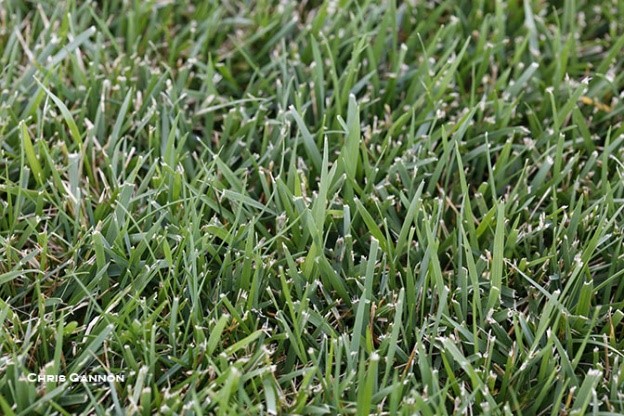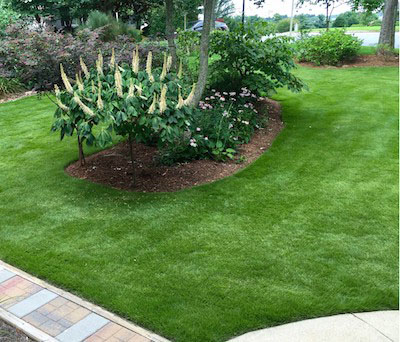Difference Between Cool Season & Warm Season Turfgrass
By Anthony Makara, Fairfax Master Gardener
Aside from having the color, Green, what else is there to know about a lawn? For the homeowner, it’s knowing which turfgrasses are better suited for our area of Northern Virginia, and of those, what additional traits are important. Is a certain turf more disease-prone? How does it look in the summer? How much care does it require? How fast or slow does it grow?

Tall fescue
Lawn turfgrasses are one of two types: cool season or warm season. The names connote the temperatures where they will thrive best. Here in Northern Virginia, we are in a lawn “transition zone,” which means that several grasses from each category will do reasonably well.
Cool season turfgrasses
These turfgrasses will grow best in temperatures of 60 to 75 F and are the first to emerge in the spring. When soil temperatures attain 40 to 60 F, root growth becomes very active. This results in major top growth early spring to early summer. The hot summer degree readings, and possible drought, cause the growth activity to drop sharply, and damage could result if conditions are severe. When the weather moderates in the fall, these turfgrasses are again in their comfort zone, and growth once again returns. If lawn replenishment efforts are needed, including re-seeding and fertilization, fall is the time to do it. Typical cool season turfgrasses found in Northern Virginia include:
Fine FescueFor general use in low maintenance areas or in partial to full shade. Less than four hours of sunlight per day. Blade is much thinner than other cool season turfgrasses. Almost needle-like and does not maintain vertical rigidity.
| Tall Fescue | A sun-loving turf with average shade tolerance. Good overall performance in the Northern Virginia lawn. Does not do well in deep shade. Very deep root system that grows as a “bunch”; i.e, does not have expanding rhizomes. A good choice for low- to moderate-maintenance lawns. |
| Kentucky Bluegrass | Sun-loving with a dark green color. Does poorly if receiving less than six hours of full sun per day. Grows in a spreading fashion via rhizomes forming a dense sod. Best during cool, moist weather on well-drained, fertile soils. More prone to turf diseases. Very slow germinating. |
| Perennial Ryegrass | Normally not very cold-hardy. Has a quick germinating quality so it is often combined with Kentucky bluegrass to show some “early green.” Performs best at higher elevations greater than 1,000 feet. A purely perennial ryegrass lawn is not recommended. An annual ryegrass seed is often included in Kentucky bluegrass based on its rapid germination. However, it is a temporary turfgrass that will not live beyond a year. |

Zoysia in summer
These turfgrasses perform best in the heat of summer when the temperature is 80 to 95 F. Greening begins when soil temperatures reach approximately 55 F. While cool season turfgrasses are slowing down in the intense heat, the warm season turfgrasses are having their major growth.
Unlike cool season turfgrasses with their growth spurts in spring and fall, warm season turfgrasses have their growth period in the summer. However, these turfgrasses will go into winter dormancy after the first hard frost. They then lose their green color and take on a light brown appearance, the color of straw. When the soil sufficiently warms again the next year in late May, new growth begins. Warm season turfgrasses are also known to be less susceptible to pests than some cool season turfgrasses. Some of the more popular warm season turfgrasses in Virginia include:
| Zoysia | Grows well in full sun. A dense, high-quality lawn with excellent heat and drought tolerance. Low- to medium-maintenance. It has a slow growth rate and handles traffic well when actively growing in hot summer months. Has better shade tolerance than Bermudagrass. Has minimal pest vulnerability. Holds up well to foot traffic. Good water use efficiency. Because of dormancy after first frost, it will appear brown throughout the winter and into spring. |
| Bermudagrass | The most aggressively spreading warm season turfgrass; often seen as a troublesome weed if growing in a cool season lawn. Aggressive growth through rhizomes (underground roots) and stolons (above ground roots.) Does not tolerate shade. |
| St Augustine grass | Of all warm season turfgrasses, this one will do the best in shade. It does not tolerate cold temperatures and is suitable mainly for the Tidewater area and points south. It has more problems with insects and diseases than other warm season turfgrasses. |
| Centipedegrass | Has a naturally yellow-green color and is unusually slow-growing with average tolerance to shade and to acid soil conditions. Also, suitable only for the Tidewater region. Although it has fewer pest problems, it does not hold up well to heavy foot traffic. |

Zoysia winter/early spring
Of overriding importance, we must ensure that our lawns are maintained in an environmentally responsible way. Knowing the soil pH is always recommended prior to fertilizer treatment for any turfgrass. Mow your turfgrass at the correct height with a sharp blade. Perform core aeration to give the roots in your lawn more oxygen. Recycle clippings in the lawn to provide natural fertilizer. And most importantly, avoid potential misuse of chemical products or pesticides.
References
• Selecting Turfgrass, Diane Relf, Virginia Cooperative Extension Publication 426-719
• What grass should I grow for my lawn?, Dr. Mike Goatley, Crop and Soil Environmental News, Virginia Tech (March 2008)
• Tall Fescue: A Low-Maintenance Alternative to Kentucky Bluegrass, Horticultural and Home Pest News, Iowa State University, Extension and Outreach
• Zoysia Factsheet, HGIC 1217 Home and Garden Information Center, Clemson Cooperative Extension